The screen shows $5000, then $4000, and $1000 a month later.
That’s your profits from the stock market, shrinking fast.
You start to panic. You feel sick to your stomach. You blame yourself for not cashing in earlier.
Maybe it is dumb luck. Maybe it is a lack of skill. Whatever the reason, you don’t wish to experience a huge profit drop. You want to protect more of your profits.
“Are there ways to trade the stock market with less risk?” you ask yourself. You begin on a quest that brought you here.
Before you jump right into the strategy, I strongly encourage you to read this article in order. You may want to save it as you digest its content.
Welcome to learning all about swing trading!
Stock Market For Dummies
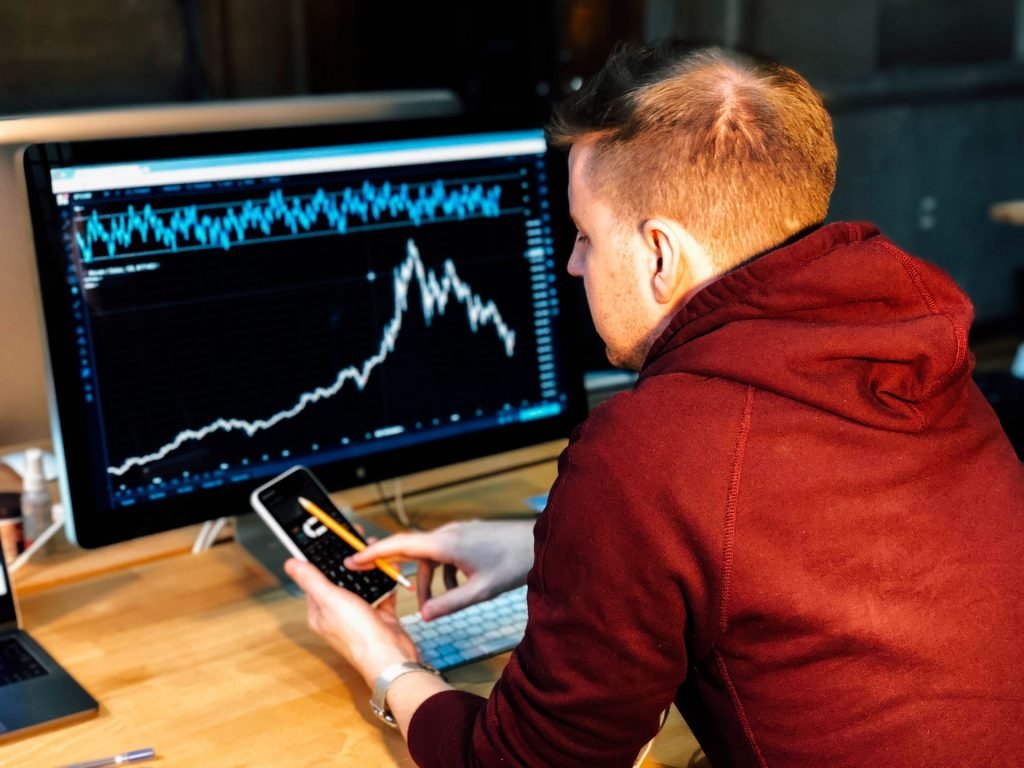
Have you heard professionals saying that the US stock market is bullish/bearish?
What are they referring to in this instance?
They are most probably referring to the S&P 500, which is made up of the top 500 companies in the US and is a good representation of the overall US stock market.
The stock market is a place where people buy and sell shares of companies (eg. CBOE, AMEX, NASDAQ, and NYSE).
Buying and selling of shares used to be done physically or through a human broker. As technology advances, stocks can be traded over the Internet.
Trading stocks over the Internet has benefits, including instantaneous transactions, reduced transaction costs, and timely information for the public.
With technology’s many advantages, is it easy to make money from the stock market?
Who participates in the stock market? Retail traders (like you and I), corporate investors, fund managers, and government are participants in the stock market.
Retail traders (that’s you and I) are the people with the least cash and significance in the stock market. This is true unless you can command an army of Redditors. Ok, jokes aside. It pays to follow what the big boys (corporate investors, fund managers, and governments) are doing. How? By following the trend.
You can follow the trend using several methods. Swing trading is one of them; you’ll discover more about it below.
What Is Swing Trading?
Swing trading is a strategy that follows the trend of prices. Prices in the stock market don’t rise indefinitely. Prices can pause by fluctuating around a level or decline.
In a bull market (where prices are on the rise), a swing is an upward move. This can last for minutes to weeks, depending on the timeframe of the chart you are looking at.
The downward moves in a bull market are known as pullbacks (aka corrections). Pullbacks tend to be swifter than swings and are usually about 10% deep.

In a bear market (where prices are on the decline), a swing is a downward move. A pullback is an upward move, and it tends to be swifter than swings (just like the ones in a bull market). Pullbacks in a bear market are stronger, at about 15 to 20%.
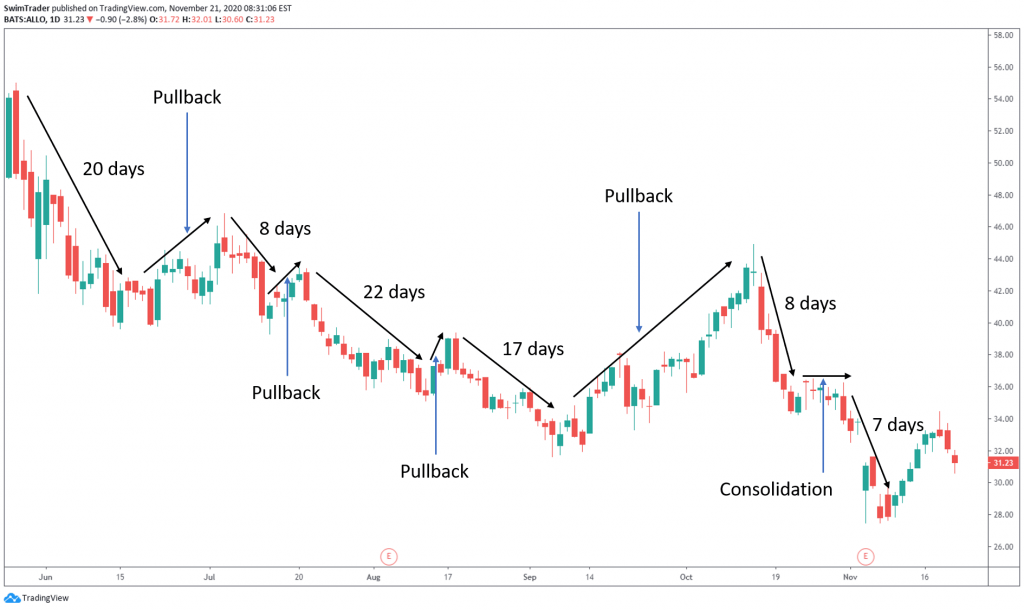
Is swing trading bound to a timeframe? No, swing trading is not limited to or defined by a timeframe, unlike day trading, which lasts for less than a day, or position trading, which lasts for weeks and longer.
You can even apply the techniques of swing trading to your day trades! But for simplicity, I’ll refer to the daily timeframe throughout this article.
Before you proceed, if you are unsure of any terminology, you may search for it in our trading glossary. It is filled with illustrations and examples to help you understand concepts at the snap of a finger.
Who Is Swing Trading Suitable For?
In the previous section, you’ve learned about swing trading.
Swing trading isn’t limited to a particular timeframe. It’s a strategy that can be applied to all timeframes.
For simplicity, I’ll refer to the daily timeframe throughout this article.

Swing trading is for you if:
#1 You don’t wish to sit in front of your computer for long hours to watch the stock market
#2 You wish to buy and hold for a few days to weeks
#3 You have 2 hours over the weekends to plan your trades
#4 You have 30 mins every weekday to monitor the stock market and enter your trades
#5 Even if you are a total beginner
If you live in Asia, you’ll love swing trading the US stock market. Like many of the members in our Facebook group, you can hold a full-time day job and swing trade at night.
As with any form of investment, please don’t trade if you are in financial distress.
Swing Trading vs Day Trading vs Position Trading
Ok, you know that swing trading can last minutes to weeks. You also know that I’ll be using the daily chart timeframe as the default.
But what is day trading? What is position trading?
Swing trading will be compared to day trading and position trading to help you find your trading style and navigate the world of stock trading.
Day trading is a form of trading where you go Long or Short and close your trade by the end of the same trading day.
Going Long means buying a stock in anticipation of its price rising and selling it at a higher price, pocketing the price difference. Going Short (or short-selling) is done by selling a stock in anticipation of its price dropping and buying it back at a cheaper price, pocketing the price difference.
You’ll have to check if your broker allows you to engage in short-selling, as this isn’t made available for all brokers.
Position trading is a form of trading (Long or Short) that usually lasts for weeks and months.
I’ve created a table to help you compare swing trading vs day trading vs position trading at a glance.

Market Research
You can leave your market research for swing and position trading to the weekend. That’ll take you about 2 hours each week.
On the other hand, you’ll need to spend about an hour each day (before the stock markets open) to scour for news that will affect the markets if you day trade.
Screen Time

As a swing trader, you’ll need to spend between 30 and 60 minutes a day watching the market and entering your trades. A position trader will also require the same amount of screen time.
However, a day trader needs to be glued to his screen as opportunities may flash by in an instant and be gone in another.
Holding Period
Since you’ll be looking for opportunities using the daily timeframe, your holding period as a swing trader will be in the days or longer.
A position trader looks to ride the longer-term trend, hence his holding period tends to be longer – from weeks to months.
A day trader will only want to hold his trade in minutes to hours as he plans to exit by the end of the trading day.
Risk-to-Reward Ratio
I know. You are wondering if there is a typo error in the Risk To Reward Ratio row in the table above. Shouldn’t your risk-to-reward ratio be equal to or less than 1?
A swing is an upward move in a bull market and a downward move in a bear market. This means that you’ll be following the trend. If the stock market is in an uptrend, the upswings tend to be longer than the corrections.
In a bear market, the downswings tend to be longer than the corrections. Hence, you can expect the swings to last longer than the corrections.
You’ll also want to capture as much of the swing as possible. This means that swings can take several days to weeks to play out. And prices don’t move in a straight line; they move in waves.
This means that if you have a tight stop loss to enhance your risk-to-reward ratio, you run the risk of getting stopped out prematurely if prices dip for a while before moving towards your profit target.
What’s the likely end result?
It’s likely to be a losing trade that could’ve gone your way if you had given your stock more breathing space. This will ultimately impact your trading results negatively and shatter your confidence.
Is there a reliable indicator that can help you avoid getting stopped out prematurely? Click here to find out about this reliable indicator and how you can use it to make money.
What Can You Swing Trade?
You can swing trade almost anything that’s made available by your broker. This means you can swing trade cryptocurrencies, commodities, currencies, ETFs, indices, and stocks.
There are just 2 criteria:
#1 Established price history
You’ll want the stock you’re looking at to have at least 2 years’ worth of price history.
#2 Trend
Newly listed instruments don’t have an established price history. Without much price history, it is difficult to conduct technical and fundamental analysis to predict how the instrument will behave in the near future.
Here’s an example:

SNOW was listed on 16 Sep 2020. That’s only 4 months ago.
There isn’t enough price history to plot the necessary support and resistance zones, trendlines and more. Don’t know what support, resistance and/or trendlines are? No worries. They will be covered in Part 2.
If a stock or instrument has been moving sideways or without a clear trend, it is not a candidate for swing trading.
Here’s an example:

The price of MSFT began to range in early Jul 2020. This ranging motion ended only in late Jan 2021. That’s 7 whole months!
If you had tried to swing trade MSFT during that period, you’d feel super frustrated because you’d make some money, only to see the profits evaporate and trigger your stop loss. If you’re lucky, you would’ve made some money.
However, your confidence would’ve been badly hit. When you are low in confidence, you question your judgment. You will be fearful. When an excellent trading opportunity shows up, you’ll be hesitant and your brain will play games with you. That’s a downward spiral that no trader wants to go through.
If you are new to trading US stocks. the next section is for you.
Which Broker Should You Use?
Please note that this section is accurate as of Nov 2020.
There are 11 main considerations to help you select a good broker.
#1 Brokerage Type

When you buy an instrument, some brokers hold it for you under your name, and others keep it in custody.
The broker holding your instruments in custody isn’t as safe because your investments are only safe if the broker doesn’t shut down. This hasn’t happened in Singapore so far, and let’s keep it this way.
Other brokers offer a unique product called Contracts for Difference (CFD).
A CFD is a derivative. It can be a derivative of stocks, indices, commodities, and so on. In this article, I shall limit it to stocks.
A CFD is also a leveraged financial product. The leverage provided ranges from 5 times to 20 times, depending on the instrument. The usual leverage for stocks is 10 times.
Leverage is a double-edged sword. An educated and seasoned trader will be able to capitalize on the leverage to grow his trading account by up to 10 times.
Losses are also magnified when leverage is used. Hence, the horror stories of traders who had losses much larger than their trading account. I’m sure you’ve heard about the tragedy of Alex Kearns, who owed his broker more than USD700,000 from trading Options (a complex and highly leveraged product).
But, if you are an educated and seasoned trader, you’ll want to make use of leverage.
#2 Regulation

It’s in your best interest to know if the broker you’d like to use is regulated in your home country and in
other countries where the laws are strict. This will allow you to seek redress if your broker is dishonest.
I’ve done the research and included it in a table at the end of this article.
#3 Demo Account
Having a demo account is beneficial as it’ll allow you to have a tour of your broker’s trading platform.
You can also practice trading to familiarize yourself with the platform before deciding to open a live account. By doing so, you’ll learn tips and features to help improve your trading efficiency.
#4 Product Range

So many instruments can be traded – bonds, cryptocurrencies, commodities, indices, stocks, and more!
Look at the products sheet to see if you can trade your favorite stock, index, or cryptocurrency. Interactive Brokers’ trading platform offers almost any bond, stock, exchange-traded fund (ETF), and index CFD.
How is cryptocurrency different?
How can you invest in cryptocurrencies safely?
What are the different categories of cryptocurrency?
Be equipped with the information you MUST know by clicking here.
#5 Bid/Ask Spread
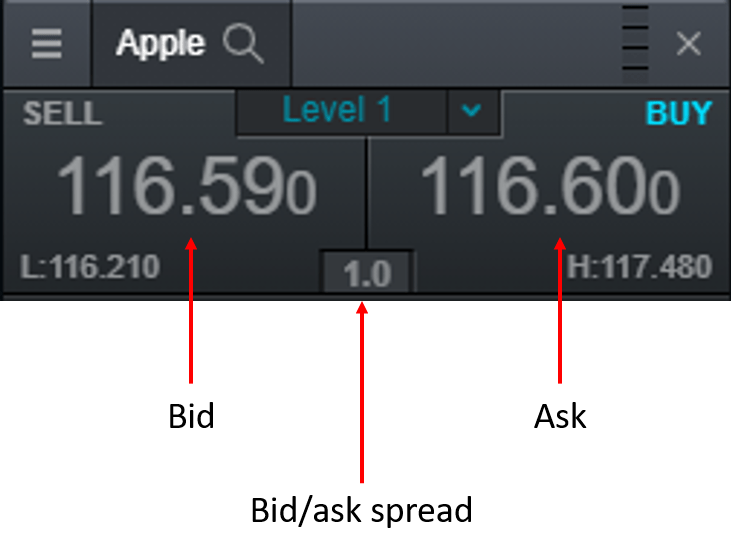
The tighter the bid/ask spread, the better. A bid/ask spread of 1 to 3 is acceptable for stocks below $50. A bid/ask spread of 1 to 6 is acceptable for stocks between $50 and $100. A bid/ask spread of 1 to 10 is acceptable for stocks above $100.
A tight bid/ask spread means that you don’t overpay for a stock when you go Long and you don’t undersell your stock when you go Short.
The width of the bid/ask spread depends on several factors:
i) Liquidity
ii) News
iii) Broker
#6 Guaranteed Stop Loss
A guaranteed stop loss ensures that you close your position at the price you determined regardless of gaps. This is especially important for volatile stocks, and you’ll discover why below.
In the chart below, the gaps in the chart of TWTR are highlighted.
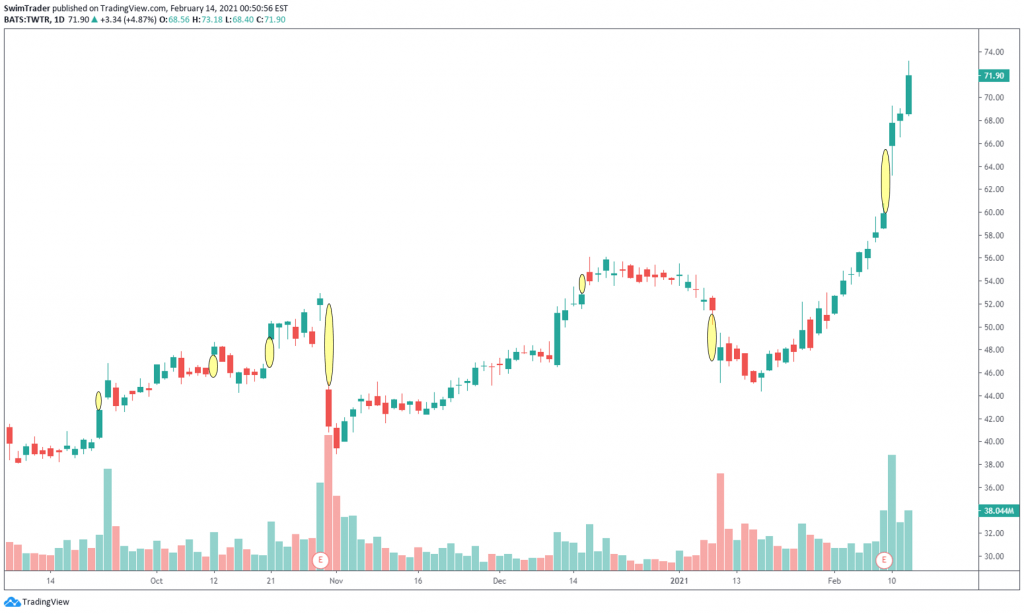
Here’s how the guaranteed stop loss works.
When you are Long and prices gap down (for any reason), the opening price may have shot below your regular stop loss level. Your regular stop loss order will therefore be triggered way below your intended price, causing you to lose more than planned.
When you are Short and prices gap up, the opening price may have pierced your regular stop loss level. This would result in steep losses.
A guaranteed stop loss will ensure you don’t get out at a worse price. You will be sure that you are able to exit your trade at the price you’ve determined.
Imagine you had bought shares of TWTR in early Jan 2021. The share price of TWTR continued to drop. In fact, it dropped by 8.7% (from $51.48 to $47.09) at the gap down (shown by the yellow oval) in just 1 day!
By having a guaranteed stop loss at $50, you’d close your trade at $50.
If you used a regular stop loss at $50, your stop loss will not be triggered at $50. Instead, it will be triggered at the opening price of $47.09. That’s almost $3 more in losses per share.
If a guaranteed stop loss is so good, there must be a cost. Yes, there is a tiny cost for this guaranteed protection.
This is a feature that CMC Markets and IG Markets (known as a knock-out) provide.
#7 Customer Service & Technical Support
Have you had a sour experience where your issue wasn’t understood? Or a time when you had to wait for a long time before hearing back?
If your broker’s trading platform is complex, you’ll want as much help as you can. This is another reason why you should sign up for a demo account first (see Point 3).
#8 Trading Platform
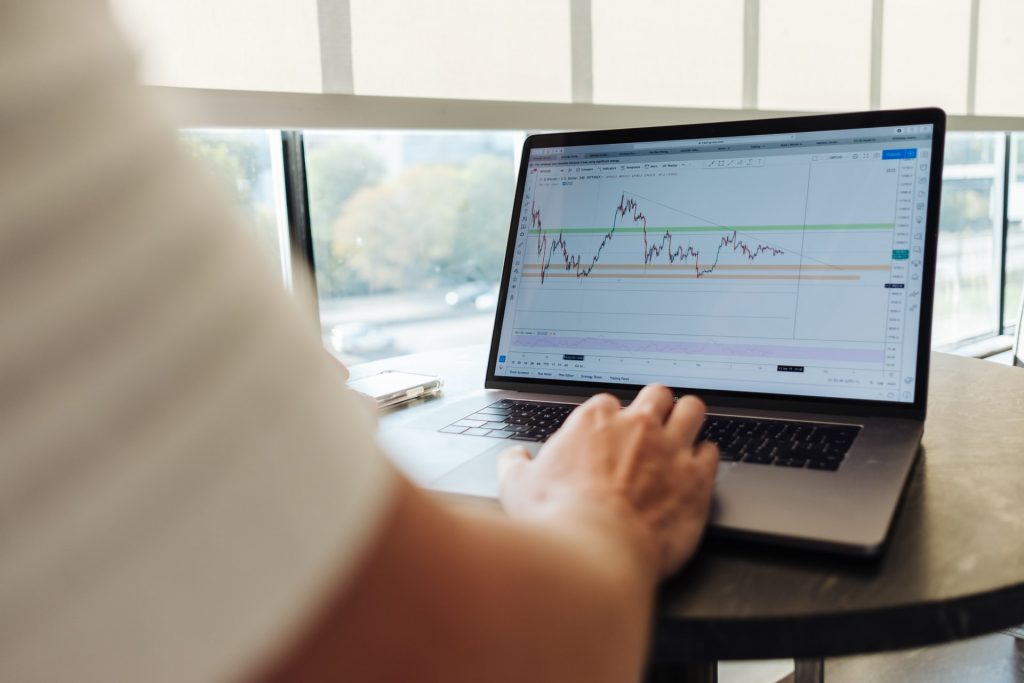
If this is your first time trading, you’ll want your trading platform to be as intuitive as possible.
The answers to “Which tool should I select to draw trendlines?” and “Where do I click to add the volume indicator?” ought to be figured out by yourself in seconds.
CMC Markets, IG Markets, Moomoo, Tiger Brokers, and Webull offer easy-to-use trading platforms that are great for beginners and seasoned traders alike.
Interactive Brokers and Phillip Securities provide a great trading platform, but learning how to use their functions takes some time.
#9 Withdrawal
Easy withdrawal of your money is a must. You shouldn’t have to wait for a week or more.
#10 Suitability
Considering all factors, you’ll want to trade with any brokers listed below.
Opening an account has never been easier. You can open an account by performing a quick search on Google.
Cheat Sheet (Updated on Apr 2024)
I know you are busy, so I’ve created this cheat sheet. I hope that you find it handy.

Claim Your Free (Limited Time) Stock Course Right Now:
The stock market is full of traps laid out by professional traders.
Many new traders are often left confused by conflicting signs and signals.
Worse still, ~80% of traders lose money.
This is because trading isn’t just about skill alone.
It includes the mastery of your emotions.
But what if I told you that you could quickly gain control over your emotions of fear and greed and master the stock market?
My team and I have worked tirelessly to help you achieve results fast.
Click on the banner below to claim your stock course for free (limited time) now!
How Much Money Do You Need To Swing Trade?
Now that you know which broker is suitable for you, you need to know how much money you need to start swing trading. Let’s explore the 4 factors which affect the amount of money you need.
#1 Stop Loss Amount
We are humans, emotional beings, and we do fail. We don’t have the nerves of steel or the discipline to sell a failing stock that we own. This is where a pre-determined stop loss level comes to the rescue.
I bet you are thinking, “Where should I place my stop loss level? How do I determine a good place to put it?”
You can use a highly reliable indicator – the Average True Range (ATR). This indicator helps you cut your losses fast and prevent premature exits. This means giving your trade time to work out before killing it.
What’s the best part?
The ATR indicator is free and available on most charting platforms.
You may want to stock to the default settings of the ATR indicator. Its reading can be found on the right side.
 In this instance, the ATR reading is 0.45.
In this instance, the ATR reading is 0.45.
The chart of F has been exhibiting nice swing points lately. If you’d like to buy shares of F and your entry price is $11.45, where would your stop loss level be?
Following the 2x ATR rule, you place your stop loss level 2x the present ATR (2 x 0.45 = 0.9). Your stop loss amount is $0.90. Your stop loss level will be at $10.55 ($11.45 – $0.90) as shown by the red box in the chart below.
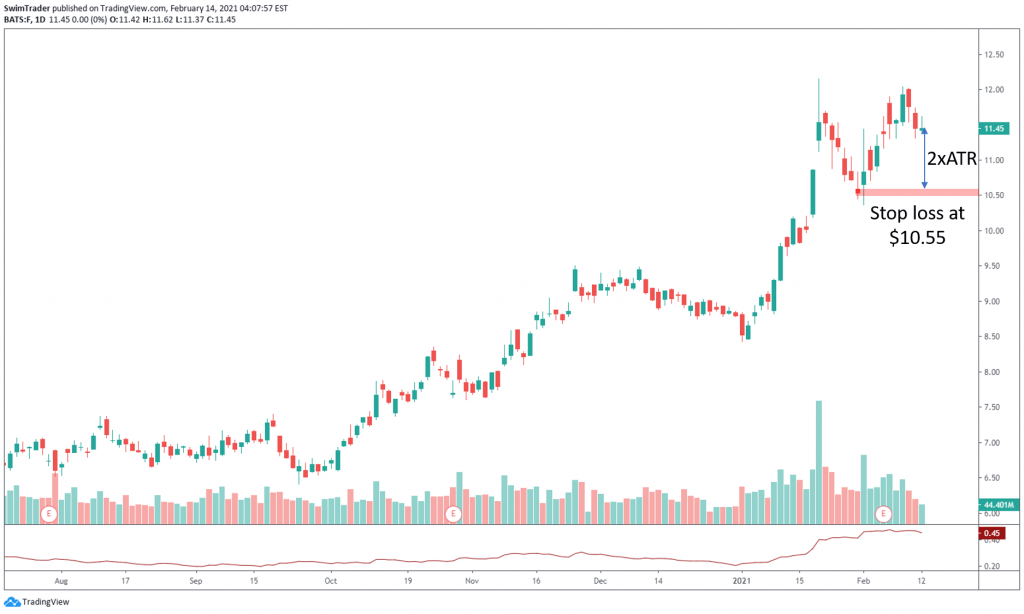
I’ll use F as a case study throughout the sub-sections below.
#2 Position Sizing
Position sizing is a formula to help you know how many units you should be buying of any instrument (ie. stocks, currencies, indices, commodities, ETFs, and more). We shall focus on stocks.

Where,
Position Sizing is the number of shares you can afford to go Long or Short with the level of risk you can stomach;
% Risk is the percentage of risk you are willing to take for this particular trade;
Allocated Trading Capital is the amount of money you want to allocate to this trade;
Stop Loss Amount is the dollar amount you are willing to lose per share.
You are thinking if there is an optimal percentage of risk for trading. Though this depends on your risk appetite, I strongly encourage you to keep it at 2% or less. This is because the more you lose, the higher in percentage terms you’ll need to recover from your initial trading account size.
Imagine risking 10% and losing $1,000 on your $10,000 trading account. You’ll need to make 11.11% to get back to even.
Worse still, if you risk and lose 50% (or $5,000), you’ll need to make 100%, as shown in the table below.
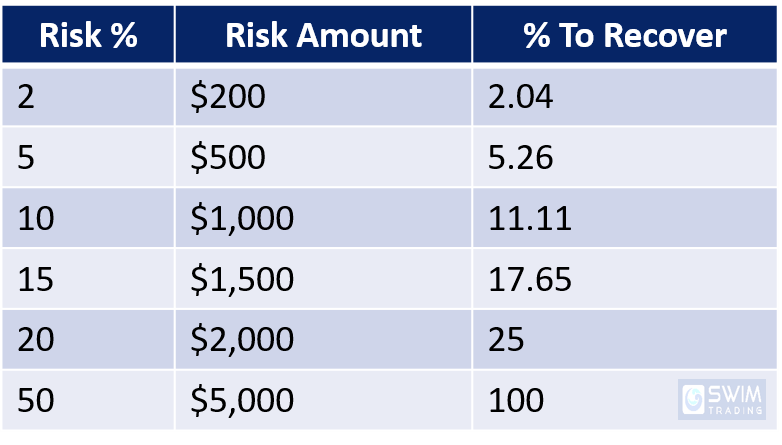
You can allocate different amounts of your trading capital for your various trades. This is also known as Allocated Trading Capital.
Say you have a $10,000. You may wish to allocate only $5,000 for F. That’s fine.
Taking a 2% risk and knowing that your stop loss amount is $0.90, what is your position size (aka number of shares that you should buy) for F?
The answer is 555.
#3 Leverage
Does your broker provide leverage?
Leverage is a double-edged sword. Using it correctly can yield greater profits than others. Conversely, you can lose more than your initial trading capital if leverage is not respected.
Should you avoid leverage altogether? The answer is No.
I’ve done a cheatsheet comparing 6 popular brokers in Singapore that support trading US stocks. You can find it in the section titled Which Broker Should You Use.
You can purchase most stocks and ETFs with a leverage between 5 and 10 times. You’ll need to consider this when you’re calculating the number of shares to buy.
Let’s say you have a trading capital of $50,000.
The performance of Amazon’s share price looks ripe for a swing trade.
Your broker grants you 10x leverage. You decide to risk only 2% of your trading capital, utilize a 5x leverage (instead of the full 10x), and set a stop loss $20 away.
Using the position sizing formula,

Let’s calculate the number of shares you can afford to buy.

You can safely buy 250 shares of Amazon with a 5x leverage.
#4 Price Of Stock
What about if you choose to swing trade the shares of Alphabet (GOOGL)?
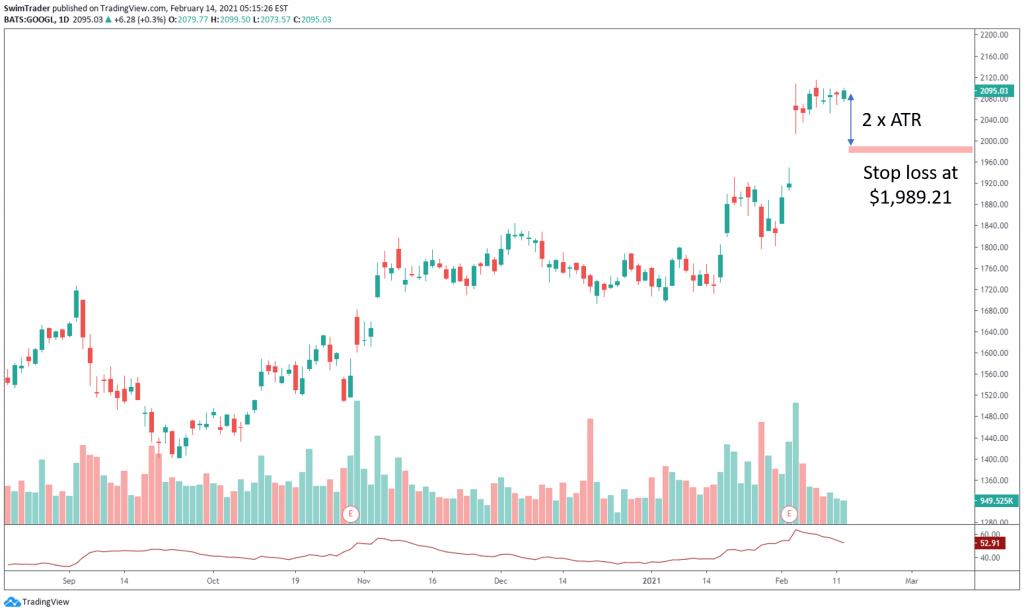
1st, you’ll need to calculate the stop loss level, which is 2x ATR. That’s $105.82 per share, which means that your stop loss level will be $1,989.21.
Allocating $5,000 with a risk of 2%, and a 5x leverage, you cannot afford to buy any shares of GOOGL.
If you allocate your full trading capital of $10,000 with a risk of 2%, and a 5x leverage, you can buy 5 shares of GOOGL.
What does this tell you?
For a high-priced stock, you’ll need more trading capital.
With a $10,000 account, you should look for stocks priced below $200. Many good and strong stocks, such as Advanced Micro Devices (AMD) and QUALCOMM (QCOM), cost below $200.
What’s A Good Charting Platform?
Knowing how much you need to get started in swing trading, you’ll now need to know which charting platform to do your homework on.
A good charting platform must have these 5 important features.
#1 Easy To Use
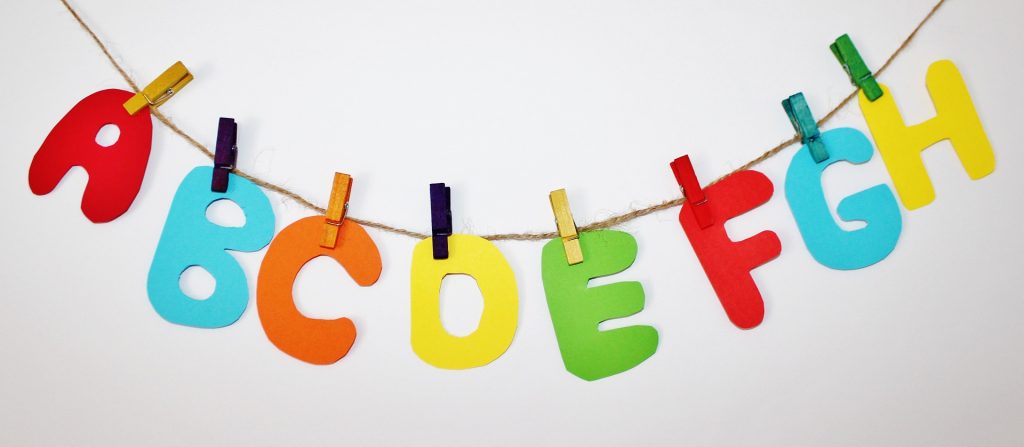
Time is precious. You won’t want to spend a large amount of time learning how to use a complicated or complex charting platform.
The charting platform you use should be clean, intuitive, and fast.
#2 Cloud Based
A cloud based charting platform is a huge advantage.
A cloud based charting platform means that you can view your charts and analysis across multiple devices as long as you are connected to the Internet. Your charts and analysis will sync across your devices for convenience.
I was out one weeknight to run errands when a good friend of mine (who’s also a trader) sent me a text notifying me of a sudden drop in the US stock market. As the charting platform I was (and am still) using is cloud-based, I could tell from my analysis if I should continue holding onto my trades or dump them immediately.
Better still, if my laptop were to crash, I wouldn’t lose my plotting and research.
And when international travel resumes, you don’t have to bring your laptop with you as you can refer to the charts on your phone. This will reduce the weight of your luggage.
#3 Extensive Database

What should your charting platform have in its database?
a) Stocks
b) Indices
c) Exchange traded funds (ETFs)
d) Commodities
e) Currencies
f) Indicators
Indicators are useful in spotting the strengths and weaknesses of the instrument you wish to trade (stocks, ETFs, indices, commodities, and currencies). Indicators such as MACD, Volume, and RSI can notify you of an impending change in trend via divergence.
Which indicators are helpful? Which should you use, and how do you use them?
In Indicator Secrets, you’ll learn about 10 helpful and easy-to-use indicators. These indicators must be available in the charting platform you use.
#4 Customization
Customization includes color, thickness of lines, and the ability to annotate.
You’ll want to be able to customize your drawings so that you know what you know so you can better spot trading opportunities.
For example, my long-term trendlines are in dotted blue, while my short-term trendlines are in dotted pink. My long-term support and resistance zones are in bold, while my short-term support and resistance zones are in grey boxes.
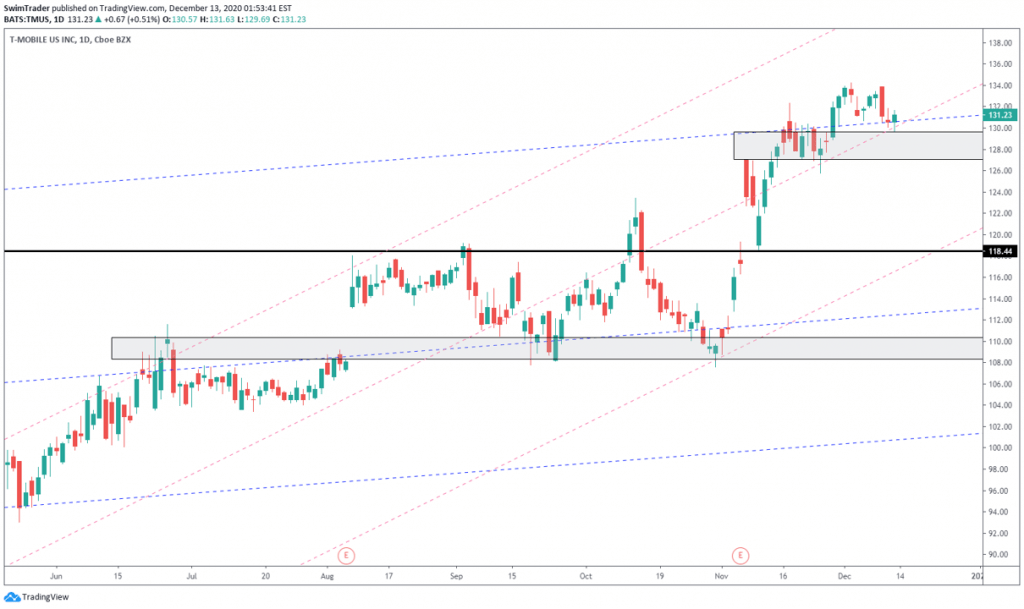 Your charting platform should also allow you to customize the duration of indicators. For example, the default period for a simple moving average (SMA) is 20. Depending on your trade’s time horizon, you should be able to change it to 30 or even 50.
Your charting platform should also allow you to customize the duration of indicators. For example, the default period for a simple moving average (SMA) is 20. Depending on your trade’s time horizon, you should be able to change it to 30 or even 50.
The same goes for other indicators, such as the Relative Strength Index (RSI) and a whole lot more.
#5 Length Of Chart Data
Some charting platforms provide data that only goes back a couple of years. To be successful at swing trading, you’ll want at least five years’ worth of charting data. Why?
You’ll want to know the characteristics of the stock you are going to swing trade on. Has it been volatile all this while? Where are the weekly resistance zones? Has it been trending or stuck in a range for years?
#6 Screener

Ok, I know I mentioned that there are 5 important features of a good charting platform. This is a bonus feature.
If the charting platform you use has a screener, you’ll be able to unearth potential winning stocks, saving you a lot of time.
What should you be filtering for? How do you do that?
The answers will be revealed in the next section titled “Fundamental Analysis For Swing Trading“.
Fundamental Analysis For Swing Trading
The analysis I do for my trades is based on fundamentals and technical. Fundamental analysis forms about 30% while technical analysis forms about 70%. This is because a company’s fundamentals don’t change as quickly as market sentiment (which is part of technical analysis). But this doesn’t mean that you should ignore doing your fundamental analysis for swing trading.
What are the key data that you want to pay attention to?
#1 Market Capitalization (market cap)
The episode of GameStop (GME) facing a short squeeze has highlighted the problem of being a small market cap company. GME’s market cap stood at approximately $1.3b in Dec 2020.
A company with a small market cap can be easily manipulated. Being a shareholder of such stocks is akin to buying a time bomb.

Since money is hard-earned, I don’t advise you to swing trade stocks with small or medium market capitalization. Instead, aim for companies with a market cap of at least $10b.
#2 Debt-to-Equity Ratio

From the debt-to-equity formula above, you’ll want the debt-to-equity ratio to be as low as possible.
No sound company would take on huge amounts of debt or have little equity.
#3 Earnings Per Share (EPS)

Because you want a high EPS score, you’ll want the total number of shares to be high, and the earnings of the company to be even higher.
A high EPS score means that the company is highly profitable.
#4 Sales Growth
Sales or revenue is the gross amount of income before the deduction of business costs.
Hence, a company that has consistently grown its revenue over the past 5 years is growing stronger.
As mentioned earlier, the fundamentals of any business don’t change that quickly, and the duration of a swing trade lasts for days to a couple of weeks. There is no need to dig too deep into a company’s fundamentals; instead, you’ll want to put more time into technical analysis.
Technical Analysis And The Tools You’ll Need For Swing Trading
You may recall that I rely mainly on technical analysis for my trades. In this section and the subsequent ones, you’ll soon learn the reasons.
What is technical analysis? Technical analysis is the study of price trends of any instrument. This means that technical analysis can be applied to cryptocurrencies, currencies, ETFs, indices, stocks, and more.
Technicians (the practitioners of technical analysis) believe that all available information has been factored into the price of any instrument. What better way to display prices than using charts? Therefore, technicians pay a lot of attention to charts such as the one below.
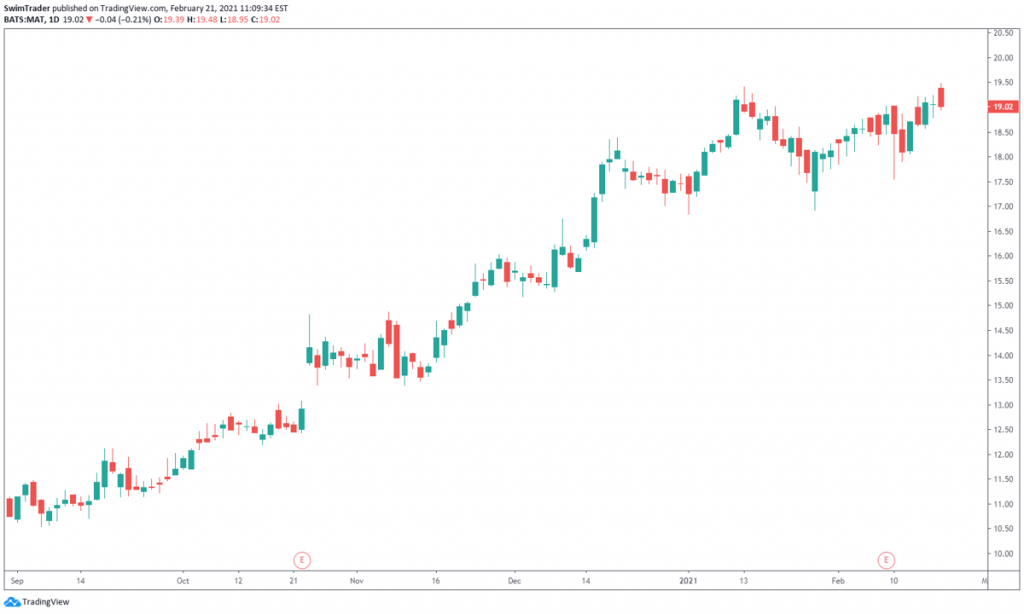
What can you tell from charts?
#1 Direction Of Prices
#2 Demand & Supply
#3 Key Levels & Turning Points
#4 Market Sentiment
#5 Volatility
Here’s an elaboration.
#1 Direction Of Prices
Charts are visual. At one glance, you can tell if an instrument’s price is trending higher, lower, or stuck within a fixed range.
Some stocks’ trends can be tricky to discern, so feel free to add an indicator to assist you.
Tool You’ll Need
The most common and simplest indicator is the Moving Average (MA). Here’s how an MA looks on the chart of Lyft (LYFT).
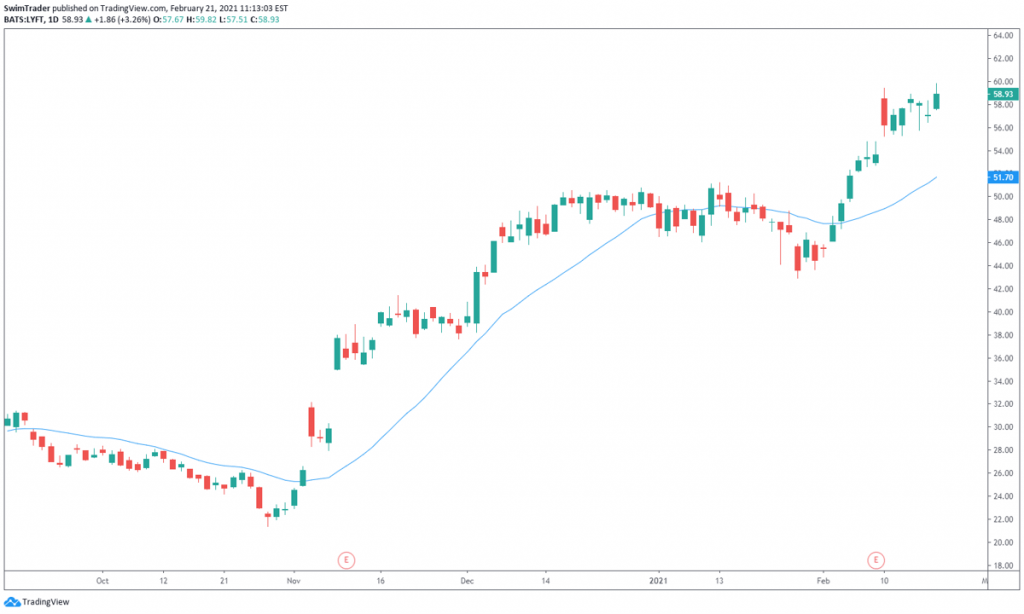
You can customize the time period of the MA. The most common time periods are 20, 50, and 200. Since swing trades usually last for days to weeks, a MA with the time period between 10 and 50 is ideal. I’ve used the 20 period MA for the chart above.
There are 2 main types of MAs too:
i) Simple Moving Average (SMA)
ii) Exponential Moving Average (EMA)
I won’t bore you with the different calculations because you can easily look it up.
The main difference is that the EMA is more responsive to changes in recent price movements than SMA is.
If the MA you have selected is sloping upwards, prices are heading up. If the MA is flat or moving up and down, prices are ranging.
Are you confused, don’t worry.
The chart of LYFT with a 20 period SMA (in blue) below will help you.

Let’s examine the same chart of LYFT but with a 20-period EMA (in orange) instead.
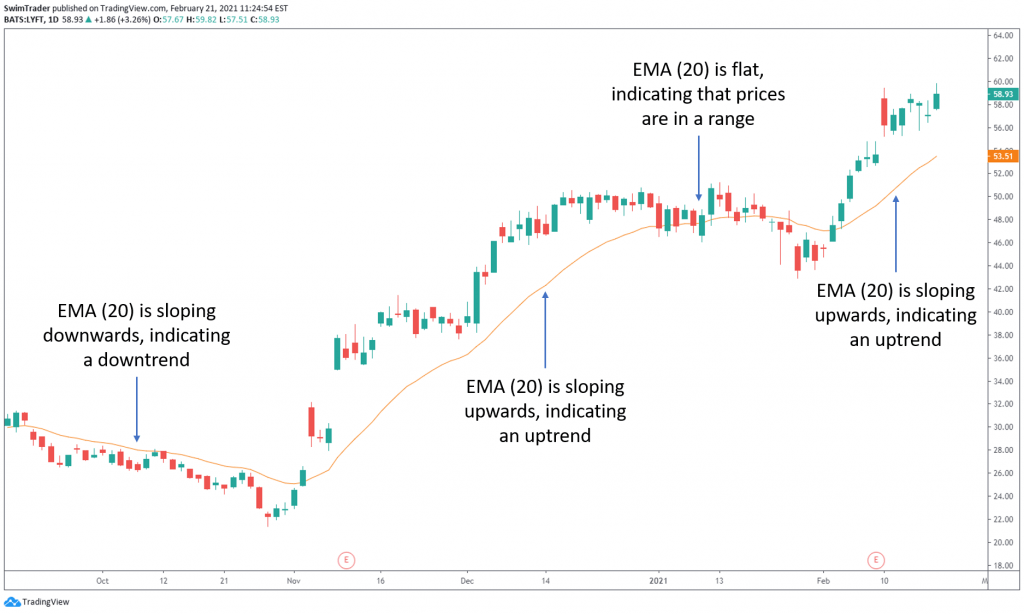
Can you tell that EMA is slightly more responsive than the same period’s SMA?
#2 Demand & Supply
There are a couple of easy ways to infer the demand and supply of any instrument: volume and support and resistance.
The best part? They are free!
Tools You’ll Need
i) Volume indicator
All good charting platforms have the Volume indicator. You can customize several display settings, but I prefer “Columns. ”
For stocks, each column of volume tells you the number of shares traded in that period of time. You’ll want to buy instruments with high volume, as this translates into high demand and supply.
Besides, instruments with high volume translates into liquidity. You’ll be able to sell your holding easily.

Now, look at the volume indicator which you have added to your chart again. What do you notice?
Did you notice that volume varies from day to day? There’re periods of high, low, increasing, and decreasing volume. Click here to learn of the 2 powerful applications of the volume indicator.
ii) Support & resistance
You may have heard of support and resistance and even mapped out support and resistance zones on your charts. But hey, do you know why this is such an important free tool in technical analysis?
Support is an area where prices find a floor, unable to break below it. Resistance is an area where prices find a ceiling, unable to break above it. A picture paints a thousand words, so let’s take a look at the chart below to illustrate this.
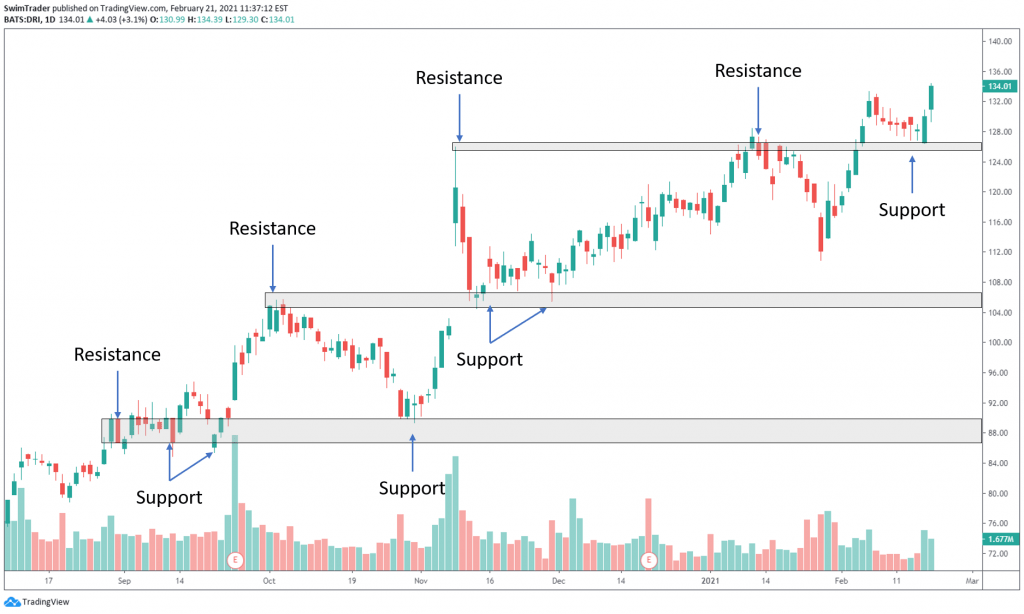
Prices are unable to break below the support zone because market participants find the price of that particular instrument to be cheap and acceptable. They’d purchase it. As demand for the instrument at that price range intensifies, prices rise. What does this mean?
Support zones are demand zones.
Prices are unable to break above the resistance zone because market participants find the price of that particular instrument to be expensive. Those who had bought earlier are inclined to sell to realize their profit. As more market participants start selling, the supply increases. This causes prices to drop as selling intensifies. What does this mean?
Resistance zones are supply zones.
As a swing trade lasts days to a couple of weeks, you’ll want to just look at the past 3 years of charting data to plot your support and resistance zones.
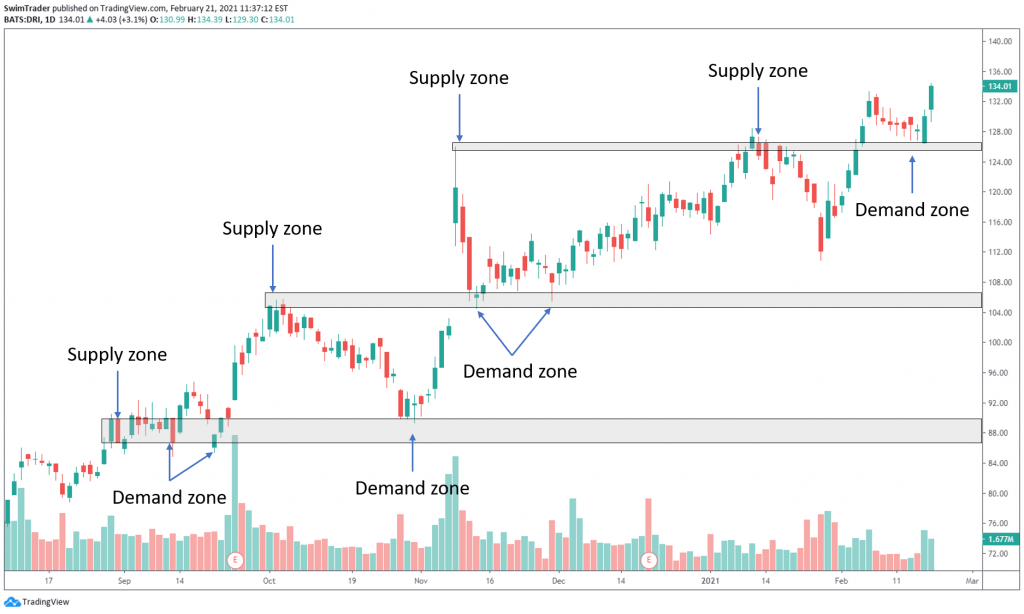
You’ve learned that support and resistance zones are demand and supply zones, respectively. The significance – prices tend to respect those levels and turn. This brings me to the next thing that technical analysis can illuminate.
#3 Key Levels & Turning Points
There are several free tools to help you identify key levels and potential turning points on any chart.
You’ll want to know in advance where these key levels and turning points are to help you plan your trade and set the right expectations. Planning your trade includes shortlisting candidates to execute swing trading and calculating the number of shares, contracts, and units (for shares, commodities and currencies, ETFs, and indices, respectively).
Which tools do you need to spot key price levels and turning points in advance? How can you do this?
Tools You’ll Need
i) Support & resistance
The use of support and resistance has been covered in the previous section, so I’ll skip repeating myself here.
ii) Trendlines
Trendlines are sloping lines that you can easily plot on your charts.
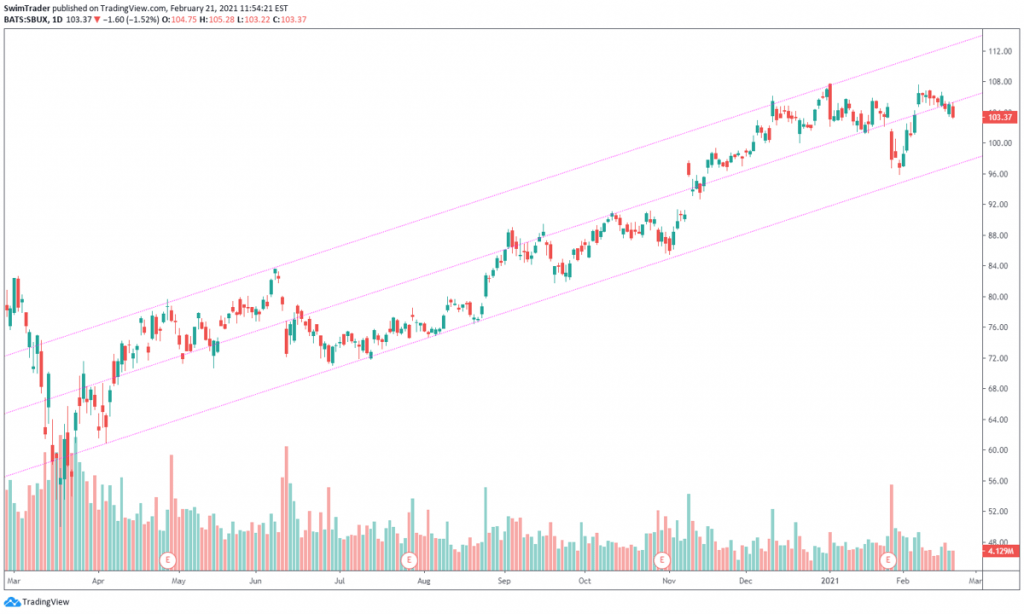
As a swing trade lasts days to a couple of weeks, you’ll just need to zoom out to start plotting your trendlines from the low of the latest crash (in March 2020) or the previous crash (in early 2019), whichever is lower.
How can you ensure that your trendlines are accurate and significant? Prices should touch your trendlines and bounce off at least 3 times.

Besides telling you of the potential turning points ahead, trendlines are able to tell you of the following too:
a) Diagonal support & resistance
Diagonal support and resistance? Remember the trait of an accurate and significant trendline? Prices should touch and bounce off your trendlines at least 3 times.
This is what support and resistance zones do too! Prices get stopped or bounce off their support and resistance zones.
b) Speed of ascent/descent

Drawing trendlines can also help you infer the speed of a particular instrument’s trend. The gradient of your trendlines can indicate the speed of any trending instrument.
Interested in knowing more about trendlines? I’ve written an article on trendlines recently and you can read it here.
Practice makes perfect, so have a go at plotting trendlines!
If you are unsure whether the trendlines you have drawn are accurate, share your chart with us on our Facebook Group and we will guide you.
iii) Pivot Points
Pivot Points is a less known indicator. However, it is widely used by professional traders.
The Pivot Points indicator is based on a mathematical formula which can be found here.
The idea behind this indicator is to buy at the instrument’s pivot point and sell at its 1st resistance level (which is termed R1) in an uptrend. If the trend is strong and shows no sign of slowing down, buy it again at its 1st resistance level and sell it at its 2nd resistance level (termed R2).
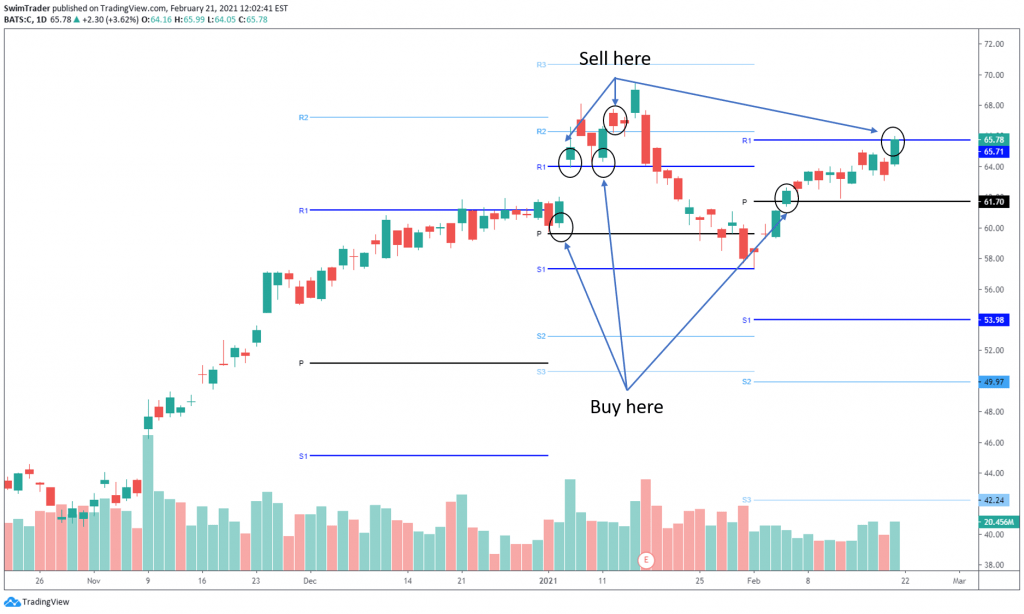
The Pivot Points indicator should have a higher timeframe than the timeframe you use for your charts. If you trade based on the daily chart, you should use the monthly timeframe for the Pivot Points indicator.
iv) Relative Strength Index (RSI)
The RSI indicator is a dynamic and powerful indicator (below the Volume indicator). It can warn you of an impeding turning point.
There are 2 main levels that the RSI indicator marks out – overbought (>70) and oversold (<30).
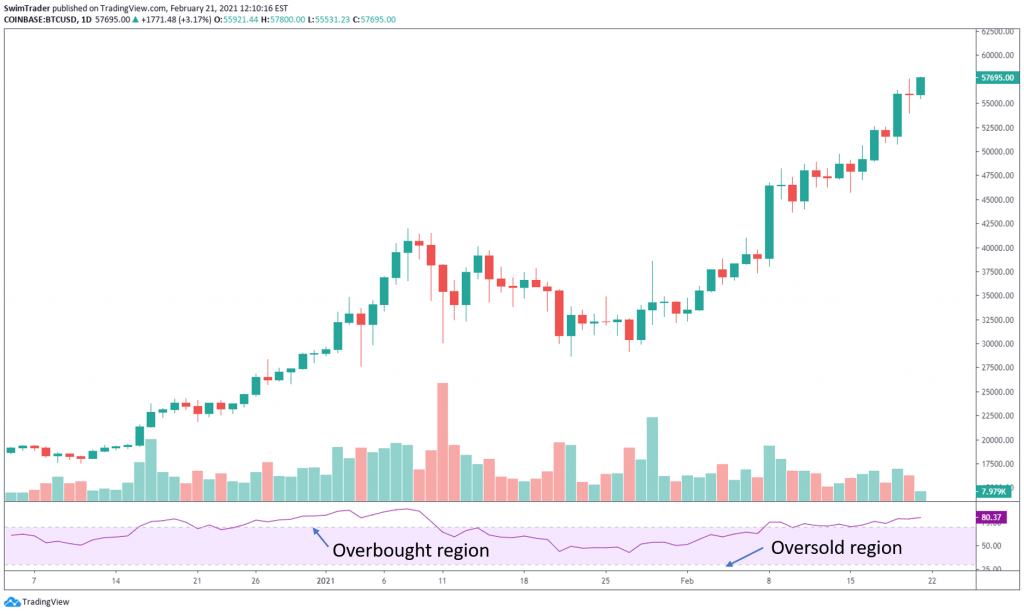
As the names of the 2 levels suggest, when the RSI reading is >70 (overbought), prices are highly inflated and should drop soon. When the RSI reading is <30 (oversold), prices have been sold to the bottom and should rise soon.
Hang on! Before you get too carried away and start buying stocks or other financial assets that are oversold (<30) or sell short those that are overbought (>70), please note that all financial assets can remain in the overbought or oversold region for some time before prices turn.
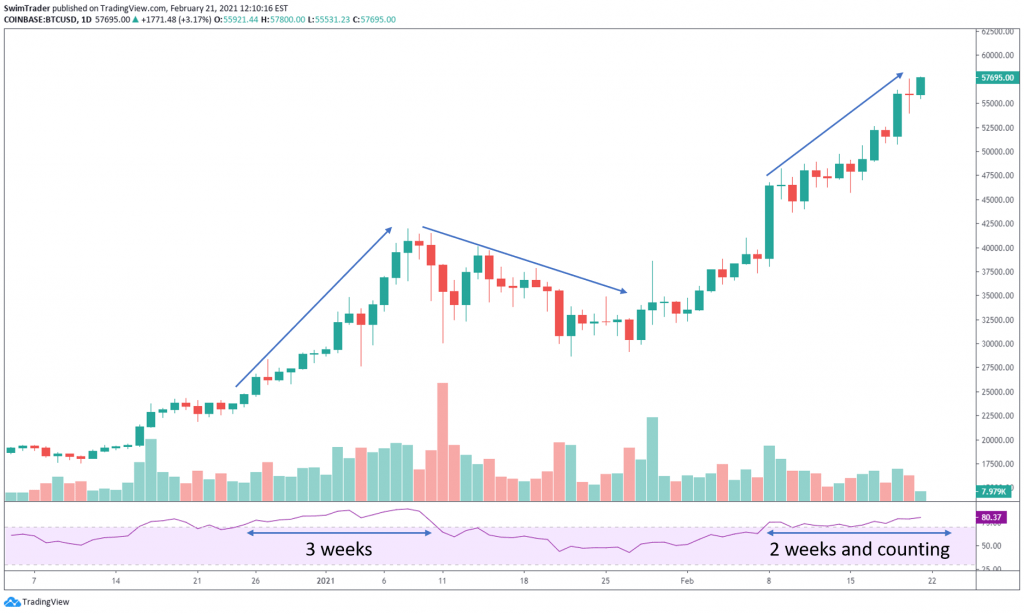
Predicting turning points is best done with a combination of 2 or more of these techniques mentioned above.
The RSI indicator is capable of much more than predicting turning points.
#4 Market Sentiment
Would you like to know if the market sentiment is bullish, bearish, or meh? Reading the market sentiment will help you time your trades, reducing your exposure to market risks.
This can be done by using the 2 tools mentioned below.
Tools You’ll Need
i) Candlesticks
Why use candlesticks?
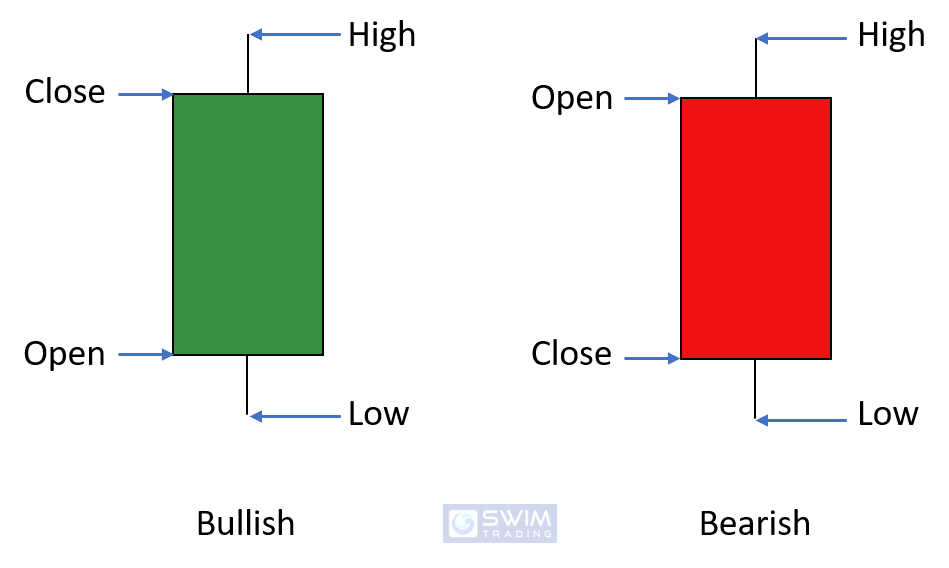

Candlesticks are rich in details that capture the market sentiment for that trading day and before. The use of candlesticks can also tell you the strength of the trend.
Before I share how you can read the market sentiment using candlesticks, here’s how to switch to viewing candlesticks on your chart.
If you are using Tradingview, you’ll see a bar at the top of your chart. Click on the icon next to the timeframes and select “Candles. ”

Now, did you notice that there are 2 colors of candlesticks – red and green? When a trading session closes higher than its opening price, the body and wicks of the candlestick are green.
When a trading session closes lower than its opening price, the body and wicks of the candlestick are red. Don’t you love how visual they are?
Did you also notice that candlesticks’ bodies differ? Some have long green/red bodies, some have short green/red bodies, and some don’t seem to have bodies at all. What’s the significance of candlestick body length?

Ok, so the candlesticks in green are bullish, and those in red are bearish. Those with a tiny body are indecision candlesticks, where the market participants are either not interested or undecided. How does this apply to the real world of trading?

As you can see from the chart of COF above, there are small and huge candlesticks. When there are large green/red candlesticks, the move up/down is steep and swift.
When the green/red candlesticks are smaller, the move up/down is more gradual.
ii) Volume

Can you recall that volume tells you the number of shares traded in that period of time? What does this mean in terms of market sentiment?
If there’s strong demand or supply, there’ll be high volume. This infers that the volume should be high when there is a trend (up and down). However, there’re moments where the price of an instrument is trending higher while the volume is low or descending. This is a red flag, signaling a change in market sentiment.
Why?
Imagine I come up with a new watch brand called Swim. It’s intricate, automatic, and made in Switzerland. It’s priced at $8,000. Will there be buyers? Maybe. It is highly likely that I’ll just have a few buyers.
One day, Drake was spotted wearing a Swim watch during an interview to promote his latest single. Other celebrities start wearing a Swim watch. All of a sudden, the world knows about Swim watches and wants it.
The price of a Swim watch rises tenfold to $88,000.
One year goes by and my watch isn’t worn by celebrities anymore. Can my watch still command $88,000? It is unlikely. Since demand and excitement have dropped, the price of a Swim watch should drop as well. It doesn’t make sense for it to hold its price tag of $88,000, especially for a new brand that’s up and against giants such as Rolex and Audemars Piguet.
As prices continue to climb/slide, demand/supply should be high, and hence, volume should be high. If volume decreases while prices climb/slide, market participants lose interest in buying/selling. A stall of the existing trend or even a trend reversal is near.
Let’s have a look.
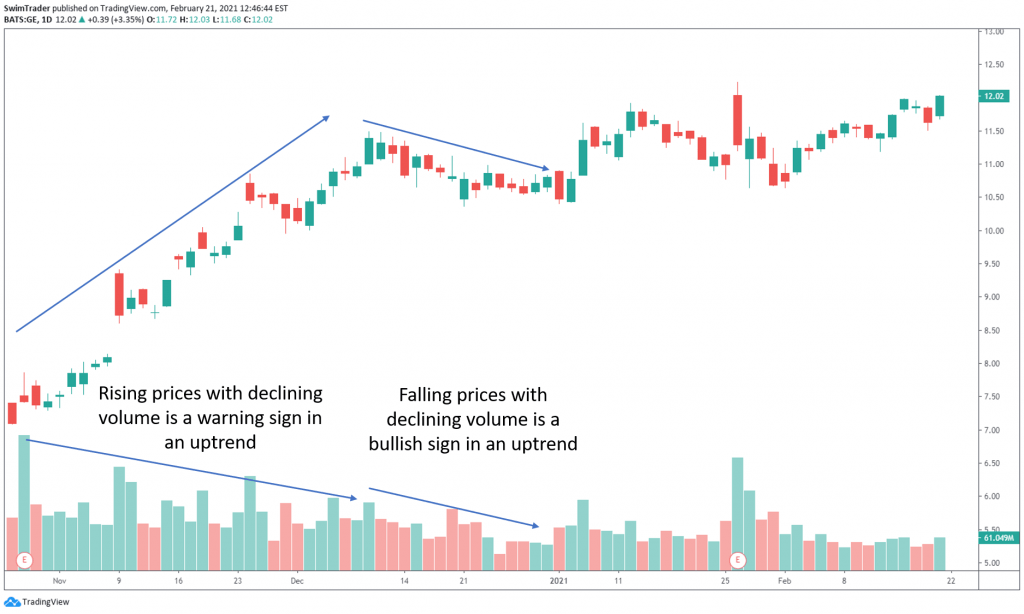
#5 Volatility
Depending on your risk appetite, you may not want to trade an instrument that’s volatile. Volatility is necessary as this means that prices are moving for you to have a chance at making money.
Do you remember the formula for position sizing?

A volatile stock widens your stop loss amount per share. This equates to the ability of buying fewer shares than those that are less volatile.
Are there tools to help you spot an increase or decrease in volatility?
Tools You’ll Need
i) Average True Range (ATR)
ii) Bollinger Bands
iii) Donchian Channels
iV) Ketlner Channels
The Bollinger Bands, Donchian Channels, and Ketlner Channels indicators can tell if an instrument is volatile. Volatility can be seen from the width of the Bollinger Bands, Donchian Channels, and Ketlner Channels. The wider the bands or channels, the higher the volatility of an instrument.
2 Swing Trading Strategies & The Psychology Behind Them
You’ve finally reached the section on swing trading strategies! Give yourself a pat on the back!
In this section, you’ll learn of 2 common yet powerful swing trading strategies and the psychology behind them. What are the 2 swing trading strategies?
#1 Flag
#2 Pennant
#1 Flag
This chart pattern is the most common and can be found in most (if not all) instruments. Please note that for the flag chart pattern to work brilliantly, the instrument’s prices must already be trending.
The flag chart pattern consists of 2 parts – pole and flag, as noted on the charts below.
Here’s an example on the chart of S1! (Silver futures).
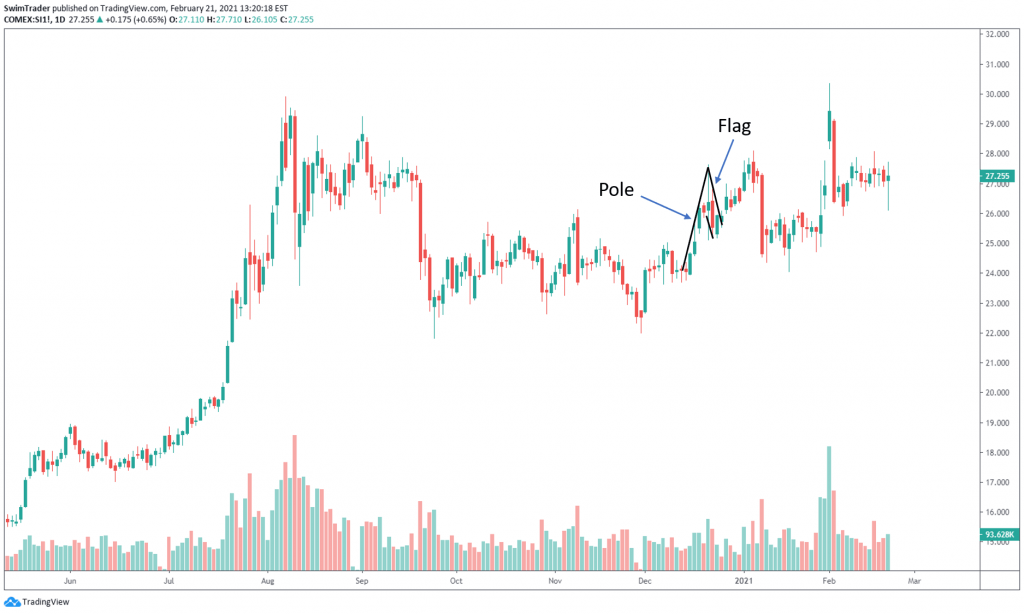
The pole is an upward/downward thrust (in an uptrend and downtrend, respectively). A steep pole is preferred.
The flag consists of 2 parallel lines that run horizontally or opposite to the direction of the pole.
Market Psychology
Volume must be high or increasing as the pole is being formed.
In an uptrend, market participants are super bullish. Demand is high as inferred from increasing or high volume. This results in a surge in prices. Therefore, there must be high or increasing volume as the pole is being formed.
Whatever that goes up must take a break or come down. Imagine sprinting 400m. Can you sprint another 400m immediately? Not unless you’re a seasoned runner.

This is the same with trading. Prices will need time to rest and recover before rising or surging again.
Therefore, there’ll be a short break from the rise. Prices will either stagnate or dip for a short while. As prices stall or decrease, there should be low or decreasing volume. Can you tell why?
When prices decrease with high or increasing volume, it means that the downtrend is likely to continue, given the supply. Falling prices with falling volume indicate that the selling is drying up, so the price decline is about to stop.
The direct opposite is true in a downtrend. Market participants are bearish. Supply is high and this can be inferred from low or decreasing volume. This causes a collapse in prices. Hence, there must be high or increasing volume as the pole is being formed.
After a while, there’ll be a short break from the decline in prices. Volume should be low or decreasing here as the sell off stalls.
Once the market participants are ready to enter the market again, demand/supply increases (in an uptrend and downtrend respectively), sending prices higher/lower. This is the moment you’ve been waiting for to buy/short-sell.
Swing Trading The Flag Pattern

Silver is in an uptrend. A perfect flag chart pattern appeared in the middle of Dec 2020.
The pole was long and steep. Volume was increasing throughout the formation of the pole.
The flag ended at $25, which coincides with the support zone. Volume was also decreasing as the flag was formed.
Take a look at the ATR and multiply it by 2 to give you the stop loss amount per ounce of Silver. That’d be $1.96.
The entry would be at $25.71. To calculate where to place your stop loss at, subtract the stop loss amount from your entry price. That’d be $25.71 – $1.96 = $23.75.
Where should you place your profit target level at? It should be placed at the next resistance.
If these rules and steps are followed, you’d have made a tidy profit of $2.30 per ounce of Silver bought. That works out to 8.9% in 2 weeks!
#2 Pennant
Although the pennant chart pattern is less common, the strategy and psychology behind it are the same as those of the flag chart pattern. Please note that for the pennant chart pattern to work according to plan, the instrument’s prices must already be trending.
The pennant chart pattern is also made up of 2 parts – pole and pennant, as pointed out by the chart below.
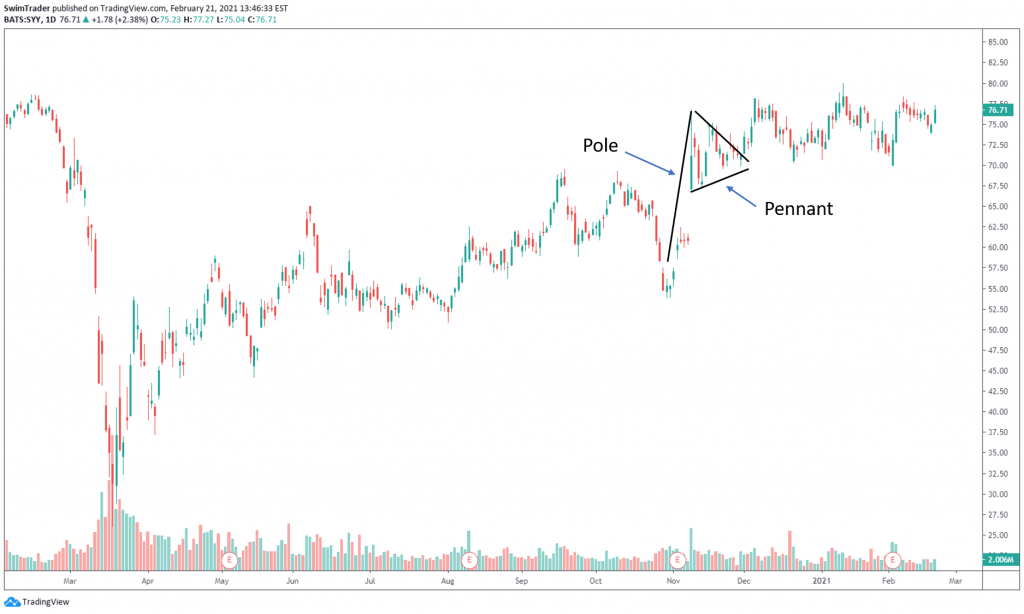
Market Psychology
In a bullish market where prices are rising, you’ll want to see high or increasing volume on the up swings and low or decreasing volume as prices pull back.
This is because the market sentiment is optimistic. Buyers are entering the market, driving up demand. There are more green and large candlesticks.
As we all know, all good things must come to an end, at least temporarily. Rising prices will have to take a break by ranging or declining a little. As prices stall or decrease, there should be low or decreasing volume.
The direct opposite is true in a bearish market. Sellers are in control, so there will be many red and large candlesticks. You’ll want to see high or increasing volume on the down swings to signal strong bearish momentum and low or decreasing volume as prices pullback.
Swing Trading The Pennant Pattern

SYY is in an uptrend. A perfect pennant chart pattern appeared in Nov 2020.
The pole was long and very steep. Volume was increasing throughout the formation of the pole.
The pennant ended at $69, which coincides with the support zone. Volume was also decreasing as the flag was formed.
The ATR was $2.62 then. Multiply it by 2 to give you the stop loss amount per share of SYY. That’d be $5.24.
The entry would be at $71.30. To calculate where to place your stop loss at, subtract the stop loss amount from your entry price. That’d be $71.30 – $5.24 = $66.06.
Where should you place your profit target level at? It should be placed at the next resistance.
If these rules and steps are followed, you’d have made a tidy profit of $7.70 per share of SYY bought. That works out to 10.7% in just a week!
Combination Of Technical Analysis Drawings And Indicators

The above-mentioned chart patterns appear all the time. Pair them with trendlines, support and resistance, volume, RSI, and ATR indicators for best results.
Why is this a good combination of indicators?
#1 Trendlines are diagonal support and resistance zones. They can also tell you the speed of ascent or descent, enabling you to maximize your money by picking the faster moving stock.
#2 Support and resistance are demand and supply zones. They tell you the areas where market participants are keen to buy or sell, causing prices to rise or fall.
#3 The Volume indicator tells you if the up or down move is legitimate. This helps you avoid being trapped in a fake move.
#4 The RSI indicator tells you if the instrument is in the overbought or oversold territory. This allows you to time your entries and exits better.
#5 The ATR indicator tells you if the volatility of the instrument and the price level to safely place your stop loss at.
Refer to the chart of Silver futures and SYY above as examples of combining technical analysis drawings and indicators to swing trading profitably.
The Mindset Of Successful Traders

Successful traders have experienced periods of loss. They have come to terms with the fact that having the right strategy doesn’t equate to winning all the time. There will still be periods of loss.
But they have mastered their trading mindset.
To master this mindset, you have to realize that the goal of trading (or swing trading for this matter) isn’t purely to make money.
The aim is to improve your trading. Aim only for the good ones and let the rest go. Missed a good trade? It’s ok. Don’t chase it. Let it go.
The other aim is to become consistent in your decision-making.
You’ll improve your trading by working on your technique, strategies, and decision-making.
Successful traders plan well, are aware of their emotions (before, during, and after buying or short-selling), stick to their plan, and are disciplined in money management.
They spend time analyzing the market and forming a watchlist, planning how much to allocate to each instrument before applying position sizing, identifying and choosing the strategy they’d like to use, plotting their charts, checking their emotions to stay calm and focused, and lastly to stick to the main plan before considering if they need to activate their contingency plan if the trade doesn’t go as planned.
Doing all the above, they hardly feel stressed because of trading. They are able to experience life with their loved ones.
Practice these qualities of successful traders. Think of improving your focus, emotional calmness, strategies, and techniques, and work on your decision-making.
21 Things You Have Learnt

#1 We are retail traders who are insignificant in the stock market
#2 Swing trading is a trend following strategy
#3 A swing in an uptrend is an upward move while a swing in a downtrend is a downward move
#4 Swing trading is even suitable for complete beginners
#5 The holding period for swing trading is longer than day trading but shorter than position trading
#6 The win rate for swing trading is much higher than the win rate for position trading and day trading
#7 Swing trading can be applied to instruments that have an established price history and trend
#8 11 important features a good broker must have (cheat sheet included)
#9 4 factors which determine the amount of trading capital you need
#10 How many shares you should buy with the trading capital you have
#11 6 essential features of a good charting platform
#12 Fundamental Analysis is important, but there’s no need to spend a lot of time on this
#13 4 data sets you’ll need to analyze a company’s fundamentals
#14 Technical analysis can tell you the direction of prices, demand and supply zones, key levels and turning points, the sentiment of market participants, and volatility
#15 How to tell if a trend is strong through the size of the candlestick
#16 There are many different technical analysis tools and indicators to help you
#17 The uses of the different technical analysis tools and indicators
#18 Spotting the 2 chart patterns correctly and entering at the right time
#19 Set your stop loss at least 2x ATR below/above your entry in an up/down trend
#20 Combine the different technical analysis tools and indicators to get the ideal result
#21 Successful traders always seek to improve on their strategies, techniques, and decision making
Claim Your Free (Limited Time) Stock Course Right Now:
The stock market is full of traps laid out by professional traders.
Many new traders are often left confused by conflicting signs and signals.
Worse still, ~80% of traders lose money.
This is because trading isn’t just about skill alone.
It includes the mastery of your emotions.
But what if I told you that you could quickly gain control over your emotions of fear and greed and master the stock market?
My team and I have worked tirelessly to help you achieve results fast.
Click on the banner below to claim your stock course for free (limited time) now!

